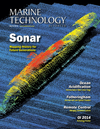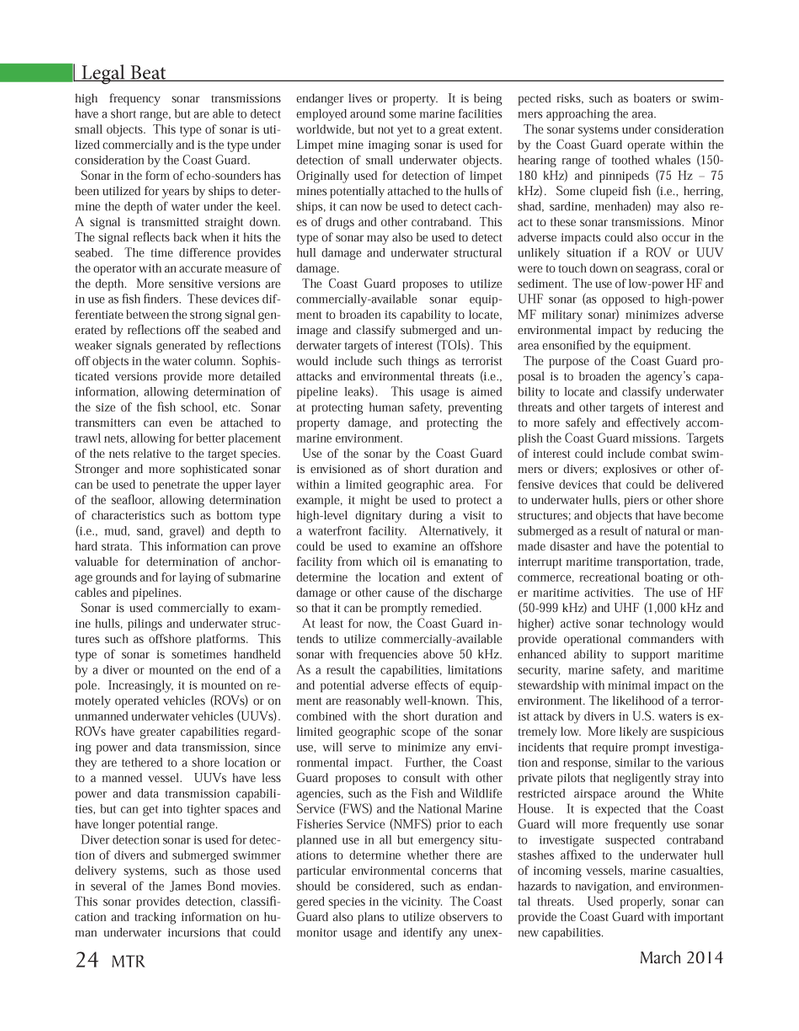
Page 24: of Marine Technology Magazine (March 2014)
Instrumentation: Measurement, Process & Analysis
Read this page in Pdf, Flash or Html5 edition of March 2014 Marine Technology Magazine
high frequency sonar transmissions have a short range, but are able to detect small objects. This type of sonar is uti- lized commercially and is the type under consideration by the Coast Guard.Sonar in the form of echo-sounders has been utilized for years by ships to deter- mine the depth of water under the keel. A signal is transmitted straight down. The signal reß ects back when it hits the seabed. The time difference provides the operator with an accurate measure of the depth. More sensitive versions are in use as Þ sh Þ nders. These devices dif- ferentiate between the strong signal gen-erated by reß ections off the seabed and weaker signals generated by reß ections off objects in the water column. Sophis- ticated versions provide more detailed information, allowing determination of the size of the Þ sh school, etc. Sonar transmitters can even be attached to trawl nets, allowing for better placement of the nets relative to the target species. Stronger and more sophisticated sonar can be used to penetrate the upper layer of the seaß oor, allowing determination of characteristics such as bottom type (i.e., mud, sand, gravel) and depth to hard strata. This information can prove valuable for determination of anchor- age grounds and for laying of submarine cables and pipelines.Sonar is used commercially to exam- ine hulls, pilings and underwater struc- tures such as offshore platforms. This type of sonar is sometimes handheld by a diver or mounted on the end of a pole. Increasingly, it is mounted on re- motely operated vehicles (ROVs) or on unmanned underwater vehicles (UUVs). ROVs have greater capabilities regard- ing power and data transmission, since they are tethered to a shore location or to a manned vessel. UUVs have less power and data transmission capabili- ties, but can get into tighter spaces and have longer potential range. Diver detection sonar is used for detec- tion of divers and submerged swimmer delivery systems, such as those used in several of the James Bond movies. This sonar provides detection, classiÞ -cation and tracking information on hu-man underwater incursions that could endanger lives or property. It is being employed around some marine facilities worldwide, but not yet to a great extent. Limpet mine imaging sonar is used for detection of small underwater objects. Originally used for detection of limpet mines potentially attached to the hulls of ships, it can now be used to detect cach- es of drugs and other contraband. This type of sonar may also be used to detect hull damage and underwater structural damage.The Coast Guard proposes to utilize commercially-available sonar equip- ment to broaden its capability to locate, image and classify submerged and un- derwater targets of interest (TOIs). This would include such things as terrorist attacks and environmental threats (i.e., pipeline leaks). This usage is aimed at protecting human safety, preventing property damage, and protecting the marine environment. Use of the sonar by the Coast Guard is envisioned as of short duration and within a limited geographic area. For example, it might be used to protect a high-level dignitary during a visit to a waterfront facility. Alternatively, it could be used to examine an offshore facility from which oil is emanating to determine the location and extent of damage or other cause of the discharge so that it can be promptly remedied. At least for now, the Coast Guard in- tends to utilize commercially-available sonar with frequencies above 50 kHz. As a result the capabilities, limitations and potential adverse effects of equip- ment are reasonably well-known. This, combined with the short duration and limited geographic scope of the sonar use, will serve to minimize any envi- ronmental impact. Further, the Coast Guard proposes to consult with other agencies, such as the Fish and Wildlife Service (FWS) and the National Marine Fisheries Service (NMFS) prior to each planned use in all but emergency situ- ations to determine whether there are particular environmental concerns that should be considered, such as endan-gered species in the vicinity. The Coast Guard also plans to utilize observers to monitor usage and identify any unex- pected risks, such as boaters or swim-mers approaching the area. The sonar systems under consideration by the Coast Guard operate within the hearing range of toothed whales (150-180 kHz) and pinnipeds (75 Hz Ð 75 kHz). Some clupeid Þ sh (i.e., herring, shad, sardine, menhaden) may also re-act to these sonar transmissions. Minor adverse impacts could also occur in the unlikely situation if a ROV or UUV were to touch down on seagrass, coral or sediment. The use of low-power HF and UHF sonar (as opposed to high-power MF military sonar) minimizes adverse environmental impact by reducing the area ensoniÞ ed by the equipment. The purpose of the Coast Guard pro-posal is to broaden the agencyÕs capa- bility to locate and classify underwater threats and other targets of interest and to more safely and effectively accom- plish the Coast Guard missions. Targets of interest could include combat swim-mers or divers; explosives or other of- fensive devices that could be delivered to underwater hulls, piers or other shore structures; and objects that have become submerged as a result of natural or man- made disaster and have the potential to interrupt maritime transportation, trade, commerce, recreational boating or oth-er maritime activities. The use of HF (50-999 kHz) and UHF (1,000 kHz and higher) active sonar technology would provide operational commanders with enhanced ability to support maritime security, marine safety, and maritime stewardship with minimal impact on the environment. The likelihood of a terror- ist attack by divers in U.S. waters is ex- tremely low. More likely are suspicious incidents that require prompt investiga- tion and response, similar to the various private pilots that negligently stray into restricted airspace around the White House. It is expected that the Coast Guard will more frequently use sonar to investigate suspected contraband stashes afÞ xed to the underwater hull of incoming vessels, marine casualties, hazards to navigation, and environmen- tal threats. Used properly, sonar can provide the Coast Guard with important new capabilities. Legal Beat 24 MTRMarch 2014 MTR #2 (18-33).indd 24MTR #2 (18-33).indd 242/21/2014 10:31:40 AM2/21/2014 10:31:40 AM

 23
23

 25
25
